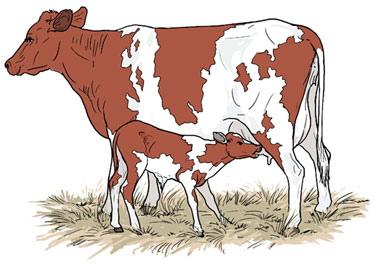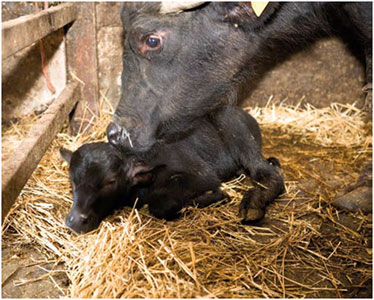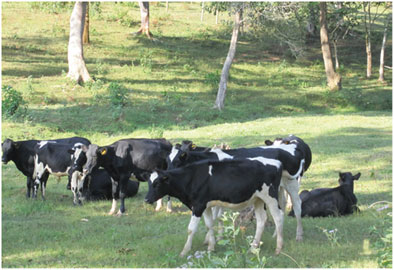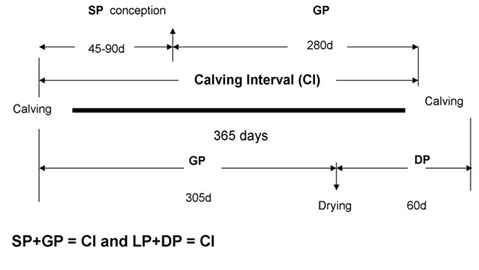 |
|
|
Translate this page in your preferred language:
|
| MANAGEMENT OF COWS AND BUFFALOES: |
| Back |
Management before birth:
- As calf management begins before birth, a few days before the calf is born, the pregnant cow is transferred to a maternity paddock, which should be near the homestead (for closer observation), well watered and free from physical objects.
- The signs of imminent parturition (calving) include filling of udder with milk and is turgid, vulva swollen with a string of mucus hanging from vagina.
- Insemination records can also be used to estimate the expected calving date.
 |
| Calf Suckling |
Management at calving:
- After the calf is born, ensure that calf is breathing. Should breathing not commence, the calf should be assisted (remove mucus from nostrils and if breathing does not start hold calf by hind legs upside down and swing several times).
- The umbilical cord should be disinfected using disinfectant (iodine or copper sulphate solution).
- If the calf is unable to suckle, it should be assisted and be allowed to suckle colostrum from the dam at will during the first week. Any excess colostrum should be milked and stored or fed fresh to other calves.
- During the second week of life and thereafter, the calf should be separated from dam and fed by hand.
Care and management of calf:
The feeding and care of the calf begins before its birth. The dam should be dried 6-8 weeks before expected calving and should be fed well. Underfed animals will give weak and small calves.
A) Early Management:
1. Immediately after birth remove any mucous or phlegm from those nose and mouth.
2. Normally the cow licks the calf immediately the birth. This helps to dry off the calf and helps in stimulating breathing and circulation.
When the cows do not lick or in cold climate, rub and dry the calf with a dry cloth or gunny bag. Provide artificial respiration by compression and relaxing the chest with hands.
3. The Naval should be tied about 2-5cm away from the body and cut 1cm below the ligature and apply Tr. Iodine or boric acid or any antibiotic.
4. Remove the wet bedding from the pen and keep the stall very clean and dry in condition.
5. The weight of the calf should be recorded.
6. Wash the cow’s udder and teats preferably with chlorine solution and dry.
7. Allow the calf to suckle the first milk of the mother i.e.
Colostrum.
8. The calf will be standing and attempts to nurse within one hour. Otherwise help weak calves to stand.
 |
| Buffalo licking her new born & transferring the desirable microflora |
B) Feeding of Calves:
1. Feed colostrum i.e. the first milk of the cow for the first 3 days.
2. Whole milk should be given after 3 days it is better to teach to drink the milk from the pail or bucket. Feed twice a day which should be warmed to body temperature.
For weak calves feed thrice a day.
3. The limit of liquid milk feeding is 10 % of its body weight with a maximum of 5-6 liters per day and continues liquid milk feeding for 6-10 weeks. Over feeding causes ‘Calf Scours’.
4. The milk replacers can be given to replace whole milk.
5. Give calf starter after one month of age.
6. Provide good quality green fodder and hay from 4th month afterwards.
7. Feeding of antibiotics to calves improves appetite, increases growth rate and prevents calf scours. E.g. aureomycin, Terramycin etc.
 |
| Feeding the calf |
OTHER MANAGEMENT PRACTICES:
1. Identity the calf by tattooing in the ear at birth, and branding after one year.
2. Dehorn the calf within 7-10 days after birth with red hot Iron or caustic potash stick or electrical method.
3. Deworm the calf regularly to remove worms using deworming drugs.
Deworm at 30 days interval.
4. Fresh water should be given from 2nd week onwards.
5. House the calves in individual calf pens for 3 months afterwards in groups.
After six months males and females calves should be housed separately.
6. Weigh the calves at weekly interval upto 6 months arid at monthly interval afterwards to know the growth rate.
7. Mortality in calves is more in first month due to pneumonia, diarrhea (calf scours) and worms. House them under warm condition, clean condition to avoid above condition.
8. Extra teats beyond 4 should be removed at 1-2 months of age.
9. 8-9 weeks of age, males should be castrated.
10. Keep the body clean and dry to avoid fungal infection.
11. Mineral-blocks should be provided, so that the calves lick and no chances for mineral deficiency occur.
12. Wean the calf from the mother and feed through pail feeding system.
Calf health:
Most of the common health problems experienced by calves are due to poor management. Some of the common problems associated with management practices are diarrhoea and pneumonia.
Common Diseases:
- Scours (diarrhoea): Scours could be caused by nutritional disorders, viruses or bacteria. Digestive upsets leading to scours are a major cause of death in young calves. The problem can however be minimised through:
- Ensuring calves receive adequate colostrum within 6 hours of birth and therefore acquire some natural immunity.
- Feeding the correct amount of milk.
- Early recognition, isolation and treatment of scouring calves.
- Maintenance of hygiene and cleanliness of feeding utensils and the environment.
- Not rearing calves continually in pens, dirt yards or small paddocks that become heavily contaminated. Paddock rotation will help prevent disease.
- Separation of sick animals to avoid cross infection.
- Close observation of calves at feeding to identify scouring animals as soon as possible for remedial treatment will prevent dehydration and secondary disease leading to chronic ill-thrift and mortality.
To minimize scours, the following should be avoided:
- Overcrowding. Provide about 20 – 24 square feet of building floor space for calves raised in confined, elevated stalls.
- Inadequate ventilation. Provide fresh air circulation in the calf pen but avoid direct drafts on the calf.
- Wet, damp calves. Provide adequate bedding and good ventilation, and avoid spraying calves with water when cleaning the pen to prevent calves becoming chilled.
- Overfeeding. Irregular amounts and too much of the wrong concentration or wrong kind of liquid diets are common causes of calf scours.
- No first-milk colostrums. Feed colostrum, preferably by hand, as soon as possible after birth.
- Dirty utensils.
Most scour incidents can be treated simply by:
• Feeding water with salts.
• Avoiding milk for 1-2 feeds. Give fresh water, concentrates and forage.
• Antibiotics should not be used to treat scours resulting from over feeding or digestive upsets. Blood scours (mostly caused by coccidia) require veterinary treatment and management changes to improve hygiene.
- Pneumonia:
- One cause of pneumonia in young calves is fluids going to the lungs via the windpipe (trachea).
- The first feeding of colostrum can cause problems if the feeding rate is faster than swallowing rate.
- If colostrum is bottle fed it is important to use a nipple that matches the calf’s ability to swallow.
- Greedy calves swallow large quantities of milk from the bucket, some of which may end up in the windpipe leading to pneumonia.
- Navel-ill:
Clinical signs: Umbilical region inflamed, Joints swell.
Management: Dress umbilicus with antiseptic at birth, Maintain good hygiene at parturition.
Care and management of Heifer:
Better care and management of heifer will give high quality replacement stock to the dairy farm.
During the early stage relatively more protein than energy is needed. Most heifers grow well if excellent hay is given. The amount of growth depends upon the quality of forage fed. Feed the heifer sufficiently to produce normal growth.
- The heifers should be provided with a dry shelter free from drafts. A loose housing system with a shelter open to one side is sufficient.
- Breeding undersized animals is never profitable. Small heifers are more likely to have difficulty in calving
- Place the heifer in a separate shed about 6-8 weeks before she is due to calve.
- Feed 2 - 3 kg of concentrate daily and all other green.
- Animals lagging behind below the required standards should be removed from the herd.
- For the heifer the calving is first time and it may have difficulty in calving. So take extra care during calving.
 |
|
 |
| Healthy heifer |
|
Different periods of dairy cow cycle
(SP: service period; GP: gestation period; LP: lactation period; DP: dry period)
|
Care and management of Lactating Animal :
To get high milk during any lactation, the milch animal should be properly fed along a proper care and management practices.
- Provide green succulent forage together with leguminous hay or straw to the extent of animal can consume, so that all its maintenance
requirements are met with through forage only.
- Extra concentrate at the rate of 1 kg for every 2 to 2.5 liters of milk should be provided.
- Salt and mineral supplements should be given to maintain the lactation.
- Never frighten or excite the animals.
- Concentrate mix is fed before or during milking, where as roughages after milking. This practice will avoid dust in the shed.
- Water should be provided adlibitum.
- Milking thrice is better than twice since 10 - 15 % more milk can be produced.
- Milking should be done with whole hand. Avoid knuckling.
- Cows should be trained to let down milk without calf suckling. This will help to wean the calves early.
- Loose housing with shelter during hot part of the day should be provided.
- The animals will get maximum exercise in loose housing system.
- Grooming of the cows and washing of the buffaloes before milking help in clean milk production.
- Daily brushing will remove loose hair and dirt from the coat.
- Grooming will also keep the animal hide pliable.
- Wallowing of buffaloes or water spraying on their bodies will keep the buffaloes comfortable especially in summer.
- Provide at least 60 days dry period between calving. If the dry period is not sufficient, the milk yield is subsequent lactation will be reduced.
- Vaccinate the cows- against important diseases.
- Every animal should be numbered and particulars pertaining to milk, fat %, feed taken, breeding, drying and calving dates should be recorded.
- Check for mastitis regularly.
Cow as a milk factory:
A dairy cow can be compared with a factory. The raw materials that go into milk manufacturing are the feeds consumed by the cow. To get more milk, feed the cow on good quality feed in large quantities. The size of the factory can be compared to the size of the cow where a large factory will hold more raw materials, so will a large cow have a larger rumen.
Animal Feeding:
Good Practice:
- Timely provision of feed to meet livestock nutritional requirements.
- Always give the animals clean and healthy feed.
- Input must be adequate in both nutritional and economic terms. Feed cows according to the stage of lactation.
- Make sure adequate water available after milking.
- Cows need clean potable water and free access to it.
Bad Practice:
- Insufficient quantity of feed supplied.
- Use of poor quality feed stuffs, Inadequate to meet the animal’s requirement, feeding unbalanced rations leads to wastage and poor performance.
- Feeding fodder that has been recently sprayed with pesticide.
- Using dirty water for drinking.
Environment:
Good Practice:
- Cleaning away waste every day.
- Separating medicine and chemical containers from other organic waste.
- Use the manure for land improvement.
- Keep the area clean and safe for animals.
Bad Practice:
- Wet unventilated dirty environment.
- Burning rubbish in the vicinity of the cows.
- Excessive use of chemicals, fertilizers and pesticides, contaminates the soil and ground water.
Care and management of bull:
- Fat males may produce semen of inferior quality or they may be slow or fail at service.
- Breeding bull should receive plenty of exercise; will usually produce large ejaculation containing more sperms of higher activity.
- A breeding bull should be housed separately known as “Bull Shed” with sufficient area of floor and proper covering.
- A balanced ration should be fed containing adequate energy, proteins, minerals, and vitamins.
Green fodder must be available both before and during breeding season.
- Most of the bulls are ferocious and so control them properly using nose rings, etc.
- It is of great importance that males should be, fed regularly and not too much at one time, and too little at another.
- For bulls two mating a day has been found to be profitable.
- Moderate exercise should be provided to keep the breeding bull in active and non fatty conditions.
- Regular grooming of the breeding bull is practiced.
- In buffalo bulls regular shaving may be practiced.
Maintenance behavior of buffaloes:
- Buffalo eat the most after morning and evening milking, and also eating moderate amounts around noon and midnight.
- Ruminating behavior was most intense after each peak of eating behavior.
- The buffalo took water three times during a 24-hour period in the cooler seasons, and four times during a 24-hour period during the warmer seasons.
|
|
Back |
|
|
Developed by :
|
Jaspal Singh
(Ex. M.V.Sc Scholar ) |
Dr. Pranav Kumar
(Assistant Professor)
|
Amandeep Singh
(Final Year B.V.Sc & AH student) |
|
|
|
|
|
|
Scroll
|
Division of Veterinary and Animal Husbandry Extension Education
Faculty of Veterinary Sciences and Animal Husbandry, R.S. Pura, SKUAST Jammu |
|





